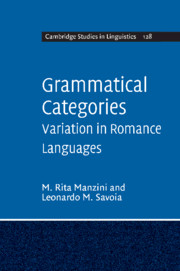Book contents
- Frontmatter
- Contents
- List of tables
- Acknowledgements
- Introduction: grammatical categories and the biolinguistic perspective
- 1 The structure and interpretation of (Romance) complementizers
- 2 Variation in Romance k-complementizer systems
- 3 Sentential negation: adverbs
- 4 Sentential negation: clitics
- 5 The middle-passive voice: evidence from Albanian
- 6 The auxiliary: have/be alternations in the perfect
- 7 The noun (phrase): agreement, case and definiteness in an Albanian variety
- 8 (Definite) denotation and case in Romance: history and variation
- Notes
- References
- Index
6 - The auxiliary: have/be alternations in the perfect
Published online by Cambridge University Press: 11 April 2011
- Frontmatter
- Contents
- List of tables
- Acknowledgements
- Introduction: grammatical categories and the biolinguistic perspective
- 1 The structure and interpretation of (Romance) complementizers
- 2 Variation in Romance k-complementizer systems
- 3 Sentential negation: adverbs
- 4 Sentential negation: clitics
- 5 The middle-passive voice: evidence from Albanian
- 6 The auxiliary: have/be alternations in the perfect
- 7 The noun (phrase): agreement, case and definiteness in an Albanian variety
- 8 (Definite) denotation and case in Romance: history and variation
- Notes
- References
- Index
Summary
The discussion in this chapter is based on a set of data which reflect microvariation in a closely related set of languages (Romance varieties) as well as variation between more distant languages (Romance and Albanian). In section 6.1 we present the basic evidence and review the notions of person split, transitivity and voice, in terms of which we analyse the data in sections 6.2 and 6.3. We discuss person-split systems in detail in section 6.2, and we concentrate on auxiliary selection according to transitivity/voice in section 6.3, arguing in particular that the notion of transitivity should be split from that of voice, and a characterization not based on movement should be adopted for the latter (cf. chapter 5). In section 6.4, we introduce some Italian varieties in which selection according to transitivity/voice and the person split cross-cut, as well as varieties in which the have/be distinction is neutralized in parts of the paradigm.
As discussed in section 6.1.1, the account we provide is crucially based on the assumption that the embedded participle does not select the auxiliary, in the sense in which a lexical category could be said to select its functional projections. Rather, the auxiliary and the participle define two independent sentences (Kayne 1993), and the selectional relation is the ordinary one from matrix predicate (the so-called auxiliary) to embedded sentence. Adopting the bi-clausal analysis just outlined for perfects amounts to eliminating auxiliaries, i.e. functional verbs, from the present grammar.
- Type
- Chapter
- Information
- Grammatical CategoriesVariation in Romance Languages, pp. 196 - 235Publisher: Cambridge University PressPrint publication year: 2011

